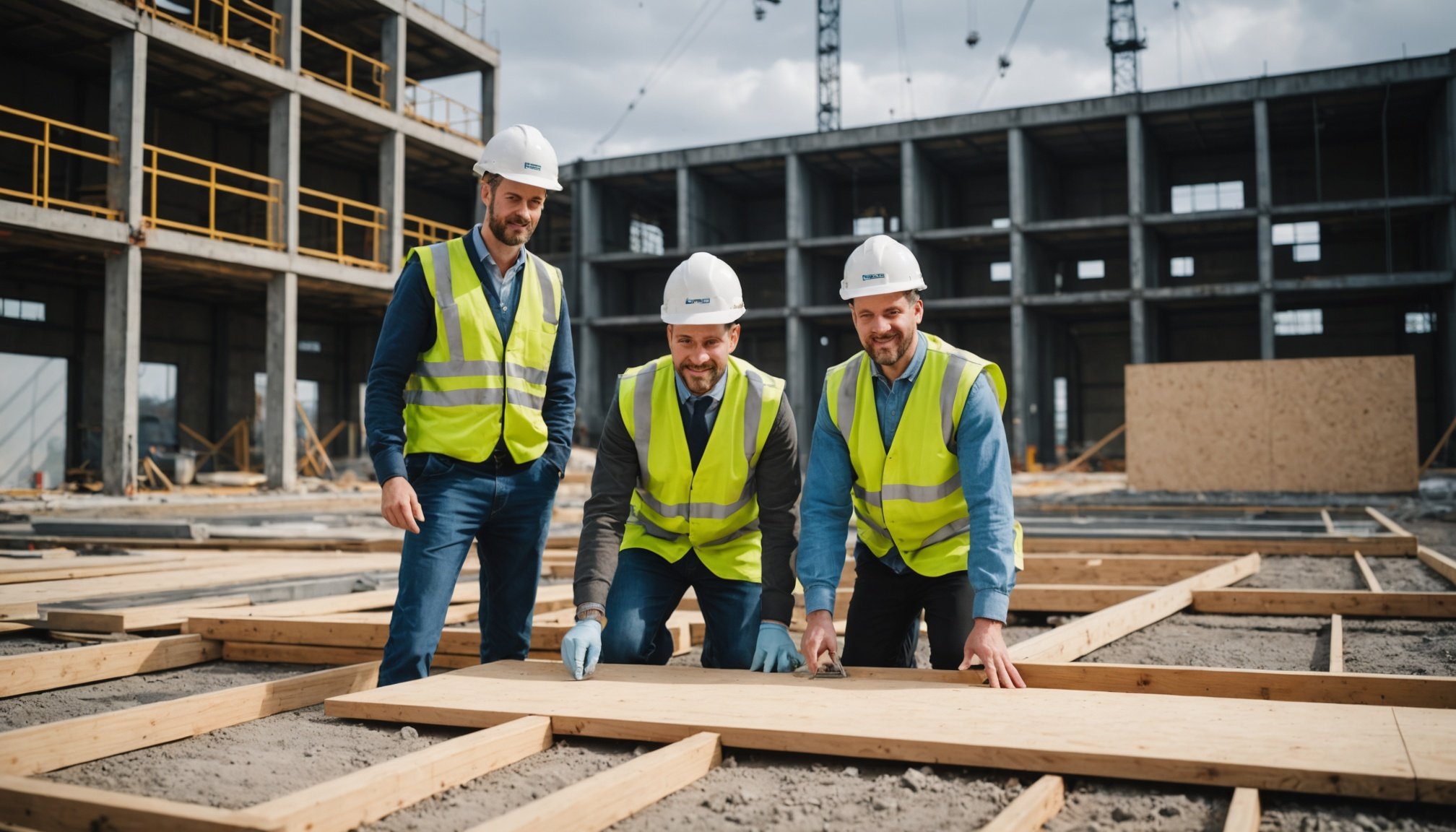Your Ultimate Blueprint for Launching a Sustainable Construction Business in the UK: Key Steps to Success
Understanding the Landscape of Sustainable Construction
Before diving into the specifics of launching a sustainable construction business in the UK, it’s crucial to understand the broader landscape and the drivers behind this growing sector. The UK government has set ambitious targets to achieve net zero emissions by 2050, and the construction industry plays a critical role in this transition.
“Sustainability is no longer a nicety, it’s a necessity,” says a spokesperson from the UK’s Department for Business, Energy & Industrial Strategy. “The construction sector must adapt to meet these new standards, and businesses that embrace sustainability will be at the forefront of this change.”
Have you seen this : Your ultimate guide to launching a telehealth platform in the uk: navigating medical data compliance with confidence
Setting Up Your Business
Choosing the Right Business Model
When setting up your sustainable construction business, selecting the right business model is essential. Here are a few models to consider:
- Cooperative Model: This model, though not common in the UK due to historical legal restrictions, can be explored through partnerships and collaborations. For example, cooperative housing models prevalent in countries like Switzerland and Belgium can inspire community-driven sustainable construction projects[1].
- Traditional Limited Company: This is the most common structure, offering flexibility and scalability. It allows for easy incorporation and the ability to attract investors.
- Social Enterprise: If your focus is on community benefit and environmental impact, a social enterprise model could be ideal. This model combines business practices with social and environmental goals.
Registering Your Business
Registering your business is a straightforward process in the UK. Here are the key steps:
In parallel : Your ultimate blueprint for launching a uk language learning app: navigating educational tech standards effectively
- Choose a Business Name: Ensure the name is unique and reflects your brand values.
- Register with Companies House: Submit your application online or by post, providing all necessary documentation.
- Obtain Necessary Licenses and Permits: Depending on the scope of your projects, you may need various licenses and permits.
Securing Funding and Support
Government Incentives and Grants
The UK government offers several incentives to support sustainable construction projects. Here are some key programs:
- Green Homes Grant: This scheme provides funding for homeowners and landlords to make energy-efficient improvements to their properties.
- Net Zero Innovation Portfolio: This program supports innovative projects that help the UK achieve its net zero target, including those in the construction sector.
- Local Authority Funding: Many local authorities have their own initiatives and grants for sustainable construction projects.
Private Financing and Partnerships
Private financing and partnerships are also crucial for sustainable construction businesses. Here are some options:
- Investors and Venture Capital: Companies like TotalEnergies and Octopus Energy are investing heavily in sustainable energy projects, which can include construction initiatives[3].
- Bank Loans and Mortgages: Traditional financing options are available, but you may need to demonstrate a strong business plan and sustainability strategy.
- Collaborations and Partnerships: Partnering with other businesses, especially those in the energy and transport sectors, can provide access to resources, expertise, and funding.
Developing a Decarbonisation Strategy
Assessing Your Carbon Footprint
To develop an effective decarbonisation strategy, you need to understand your business’s carbon footprint. Here are the steps to follow:
- Conduct a Carbon Audit: This involves assessing all aspects of your business, from supply chains to energy usage.
- Identify Key Emission Sources: Focus on areas such as energy consumption, transport, and material usage.
- Set Reduction Targets: Based on your audit, set realistic and achievable reduction targets.
Implementing Sustainable Practices
Here are some practical steps to implement sustainable practices in your construction business:
- Use Low Carbon Materials: Opt for materials with low embodied energy, such as recycled materials or sustainably sourced timber.
- Energy-Efficient Design: Design buildings with energy efficiency in mind, using techniques like passive house design and integrating renewable energy systems.
- Sustainable Supply Chains: Ensure your supply chains are sustainable by sourcing materials locally and reducing transport emissions.
Managing Your Projects Sustainably
Project Management Best Practices
Effective project management is crucial for sustainable construction projects. Here are some best practices:
- Integrated Project Management: Involve all stakeholders from the outset, including architects, engineers, and contractors. This integrated approach ensures that sustainability is considered at every stage of the project[1].
- Life Cycle Costing: Consider the total cost of ownership, including maintenance, operation, and eventual decommissioning.
- Quality Control: Ensure that all materials and work meet high sustainability standards.
Tools and Technologies
Utilize tools and technologies that support sustainable project management:
- Building Information Modelling (BIM): BIM helps in designing and managing projects more efficiently, reducing waste and improving sustainability.
- Sustainability Software: Use software that tracks and analyzes the environmental impact of your projects.
- Energy Efficiency Tools: Tools like energy simulation software can help optimize building performance.
Building a Sustainable Supply Chain
Sourcing Sustainable Materials
Sourcing materials sustainably is a key aspect of your decarbonisation strategy. Here are some tips:
- Local Sourcing: Source materials locally to reduce transport emissions.
- Certified Sustainable Materials: Look for materials certified by organizations such as the Forest Stewardship Council (FSC) for timber.
- Recycled Materials: Use recycled materials wherever possible to reduce waste and the demand for new raw materials.
Partnering with Sustainable Suppliers
Partnering with suppliers who share your sustainability goals is essential. Here’s how you can do it:
- Supplier Audits: Conduct regular audits to ensure suppliers meet your sustainability standards.
- Contractual Agreements: Include sustainability clauses in your contracts with suppliers.
- Collaborative Improvement: Work with suppliers to improve their sustainability practices.
Navigating Regulatory Requirements
Compliance with Building Regulations
The UK has stringent building regulations that support sustainability. Here are some key regulations to comply with:
- Building Regulations 2020: These regulations include standards for energy efficiency and sustainability in new buildings.
- Net Zero Carbon Buildings: The UK government aims for all new buildings to be net zero carbon by 2050. Ensure your projects align with this goal.
Environmental Impact Assessments
Conducting environmental impact assessments is crucial for large-scale projects. Here’s what you need to do:
- Screening and Scoping: Determine the potential environmental impacts of your project.
- Assessment and Mitigation: Assess the impacts and develop strategies to mitigate them.
- Monitoring and Review: Continuously monitor and review the environmental impact of your project.
Case Study: Xlinks Morocco – A Global Example of Sustainable Infrastructure
The Xlinks Morocco project is an exemplary model of sustainable infrastructure development. Here’s what we can learn from it:
- Renewable Energy Integration: The project involves generating up to 10.5 GW of renewable energy from solar and wind sources in Morocco and transmitting it to the UK via subsea cables[3].
- International Collaboration: The project is a result of collaboration between major players like TotalEnergies, Octopus Energy, and TAQA, demonstrating the power of international partnerships in achieving sustainable goals.
- Innovative Technology: The use of high-voltage direct current (HVDC) cables for energy transmission highlights the importance of innovative technologies in sustainable infrastructure projects.
Practical Insights and Actionable Advice
Start Small but Think Big
- Begin with smaller projects to test your sustainability strategies before scaling up.
- Always keep the long-term vision in mind, aligning your projects with the UK’s net zero targets.
Engage with Stakeholders
- Collaborate with local communities, suppliers, and other stakeholders to ensure your projects are socially and environmentally sustainable.
- Engage in continuous dialogue with your clients to understand their needs and develop tailored sustainability solutions.
Stay Updated with Industry Trends
- Keep abreast of the latest technologies and practices in sustainable construction.
- Attend industry conferences and workshops to network and learn from peers.
Launching a sustainable construction business in the UK requires a comprehensive approach that integrates sustainability into every aspect of your operations. From choosing the right business model and securing funding to managing projects sustainably and navigating regulatory requirements, each step is crucial for success.
By following the blueprint outlined above, you can ensure that your business not only thrives but also contributes significantly to the UK’s transition to a low-carbon economy.
Detailed Bullet Point List: Key Steps for Launching a Sustainable Construction Business
-
Conduct Market Research:
-
Understand the demand for sustainable construction services.
-
Identify competitors and market gaps.
-
Develop a Business Plan:
-
Define your mission, vision, and sustainability goals.
-
Outline your business model, target market, and financial projections.
-
Secure Funding:
-
Explore government incentives and grants.
-
Seek private financing and partnerships.
-
Consider crowdfunding or community-based funding models.
-
Register Your Business:
-
Choose a unique business name.
-
Register with Companies House.
-
Obtain necessary licenses and permits.
-
Develop a Decarbonisation Strategy:
-
Conduct a carbon audit.
-
Identify key emission sources.
-
Set reduction targets and implement sustainable practices.
-
Build a Sustainable Supply Chain:
-
Source materials locally and sustainably.
-
Partner with suppliers who share your sustainability goals.
-
Conduct regular supplier audits.
-
Manage Projects Sustainably:
-
Use integrated project management approaches.
-
Implement life cycle costing and quality control measures.
-
Utilize tools and technologies that support sustainability.
-
Navigate Regulatory Requirements:
-
Comply with building regulations and environmental impact assessments.
-
Stay updated with changes in regulatory requirements.
-
Engage with Stakeholders:
-
Collaborate with local communities and suppliers.
-
Engage in continuous dialogue with clients to develop tailored sustainability solutions.
-
Stay Updated with Industry Trends:
-
Attend industry conferences and workshops.
-
Keep abreast of the latest technologies and practices in sustainable construction.
Comprehensive Table: Comparison of Sustainable Construction Practices
| Practice | Description | Benefits | Challenges |
|---|---|---|---|
| Low Carbon Materials | Use of materials with low embodied energy | Reduces carbon footprint, improves energy efficiency | Higher initial cost, limited availability |
| Energy-Efficient Design | Design buildings with energy efficiency in mind | Reduces operational energy consumption, improves comfort | Requires specialized expertise, higher upfront cost |
| Sustainable Supply Chains | Source materials locally and sustainably | Reduces transport emissions, supports local economy | Requires robust supplier management, potential supply chain disruptions |
| Integrated Project Management | Involve all stakeholders from the outset | Ensures sustainability is considered at every stage, improves project efficiency | Requires strong communication and coordination skills, potential for increased complexity |
| Life Cycle Costing | Consider the total cost of ownership | Helps in making informed decisions, reduces long-term costs | Requires detailed analysis, potential for higher upfront costs |
| Environmental Impact Assessments | Assess and mitigate environmental impacts | Ensures compliance with regulations, reduces environmental harm | Time-consuming and costly, requires specialized expertise |
Quotes from Industry Experts
- “Sustainability is not just about reducing emissions; it’s about creating a better future for all stakeholders involved in the construction process.” – UK Department for Business, Energy & Industrial Strategy
- “The key to successful sustainable construction is integrating sustainability into every aspect of your operations, from design to delivery.” – Alfonso Garcia Larriu, Director General of Liberty Specialty Markets in Spain
- “Collaboration and innovation are crucial for achieving sustainable goals in the construction industry. We must work together to develop and implement new technologies and practices.” – Dayae Oudghiri Kaouach, President and CEO of Xlinks Morocco Development[3].











